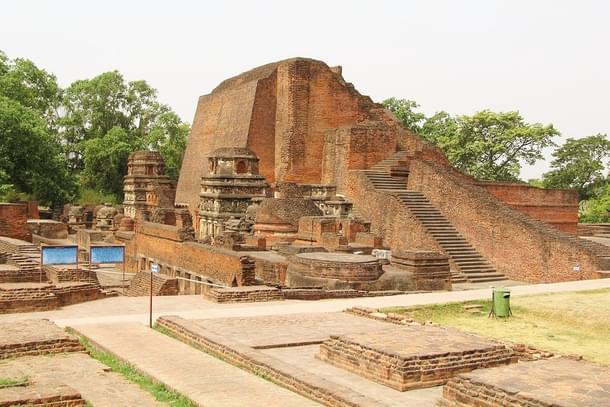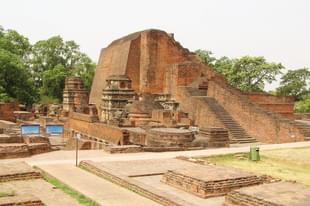Magazine
An Indic Renaissance Is Far From Complete
Makarand Paranjape
Apr 30, 2018, 11:45 PM | Updated 11:45 PM IST
Save & read from anywhere!
Bookmark stories for easy access on any device or the Swarajya app.


On the last day of the “Dharma-Dhamma” conference, 11-13 January 2018, that occasioned my visit to the region and this mediation, I stepped out to go to the ruins of Nalanda. This world-famous mahavihara, whose splendours were known throughout the ancient world and a glimpse of which we have just related in a previous column, was a mound of rubble until the British, curious, decided to dig it up. What we see now has been reassembled, not all of it excavated even.
I went with two Adityas, one who works for the India Foundation, another who is a student at Nalanda University, studying history and archaeology. Though the whole site is now a UNESCO World Heritage Monument, what we saw is rather disappointing. Even the signage is inadequate, what to speak of other facilities. Even the perimeter wall is broken in some places. Stray dogs and cows wander in and out of the premises, as do local villagers and their children. Several of the monuments are quite unkempt, some with graffiti and pan and stains of betel spittle on what were once the cells for the monks and teachers.
There are some impressive temples, but they were closed. Foreign tourists had lit incense outside, but the ancient shrines, locked against vandalism, looked derelict and neglected. Some pits that had been carefully excavated decades ago, during a former, more enthusiastic period leading up to the UNESCO certification, are now filling up with mud and rubbish. The shards of pottery and images strewn about in these dugouts mingle seamlessly with soft-drink tetrapaks, biscuit and potato chips wrappers, and other accessories of a consumer culture. A clash of two dharmas, perhaps?
The guides are not well-educated which is, of course, not their fault. Unfortunately, they make up stories when they don’t know facts. They cannot properly explain, for instance, why the walls of the ruined monasteries are blacked. When I tell them that they were torched hundreds of years ago, they look at me uncomprehendingly. Nor can they explain which structures are original and which reconstructed from the rubble and ruins. What exactly happened here? Who were the perpetrators? What kind of knowledge did the monks and teachers possess? None can properly explain. Then how can they show us the way to reconnect with it?
Most local people look to these sites merely as a way to earn a living from the tourist traffic that frequents them. We are no different as far as they are concerned. Our questions, curiosity, and anguish do not matter to them. How can we have a second Indian renaissance if the majority of our people do not know what we had, what was lost, or how we might get a part of it back? Even the more educated ones amongst us would have been mostly in the dark had not the British colonialists thought of giving us back our ancient history, no doubt for reasons of their own.
Dr Ravindra Pant, member of the team that excavated the site, said in an interview to a leading English daily, “Today we know only 10 per cent of Nalanda. We have to find the remaining 90 per cent of the campus. We have to properly map it to rebuild. Right now these mounds are like a jigsaw puzzle.” I was flabbergasted to realise that what we had seen was just this 10 per cent of excavation, which uncovered 11 monasteries, six large adobe brick temples, and several centres of learning, study, debate, not to mention libraries, granaries, monks’ quarters, and secret chambers to hide valuables. Imagine how big the entirety of this destroyed and ruined university town might actually have been. Then imagine the kind of loss the world would have suffered by the gruesome and wanton destruction of such a knowledge hub.
The best-preserved and restored sections show that the whole campus was enclosed in a tall brick wall. The main gate opened onto the principal building of the great college, around which are eight other halls. As a contemporary described it, “the richly adorned towers, and the fairy-like turrets, like pointed hilltops, are congregated together. The observatories seem to be lost in the vapours (of the morning), and the upper rooms tower above the clouds.” As we have already seen, the great Chinese pilgrim-scholar, Xuanzang, a contemporary and honoured guest of possibly the last great Hindu king of classical times, Harsha, catalogued the riches of Nalanda in some detail, while he was a resident there. Now a magnificent, modern pavilion, ironically in much better shape and standing than Nalanda itself, adorns the area not too far from these ruins.
Why hindus must not become anti-Muslim
In my last column in this series (“Conquest and Memory”, Swarajya, April 2018), I had cautioned against the dangers of Hindus turning anti-Muslim after learning about the gruesome, some would say genocidal, history of the Muslim conquest of India. True, Hindus have a right to be angry on at least two counts. First, at the brutal and unsparing nature of these conquests, which almost uprooted and ended their way of life. Secondly, at the false and suppressed histories of that period, trying to shore up utterly unsustainable canards about the “secular” nature of these conquests, airbrushing the damage and mayhem suffered by the indigenous culture at the hands of the invaders. But, as I already indicated, anger against contemporary Muslims, often themselves descendants of a forcibly converted and subjugated underclass, would be utterly misdirected.
What is required, instead, is to wean away our sub-continental Muslim brethren from triumphalist and distorted accounts of the past. For them to acknowledge the horrors of Muslim rule in India, with whatever notable exceptions come to light, is absolutely essential to a reconciliation between Hindus and Muslims today. Such a reconciliation is unfortunately impossible for Pakistan, which sees itself as upholding and championing the legacy of these very conquests and depredations. So it is Indian Muslims who must be invited to re-examine this record to begin with.
In the second phase of the Indian renaissance, those convinced of the terrors and sorrows inflicted upon Indians by these despots and tyrants could very well re-join the “Hindu” narrative. This, to my mind, is what A P J Abdul Kalam himself exemplified, although he did not spell it out in so many words. A Hindu, pluralistic narrative will give enough space for all, allowing the secular state to continue its business without appeasing or discriminating against any section of the populace. This dharmic framework might serve better, in fact, than the politics of pseudo-secularism that has divided us for the last 70 years of our existence as an independent country.
Isn’t an acceptance that their best interests lie in joining the Hindus a logical step forward for Indian, one might even say, “Hindu” Muslims? Especially now that their last hope, Pakistan, has shown itself not only to be a failed experiment as the pure and ideal nation of sub-continental Muslims, but also the sponsor of worldwide terrorism, quite aptly termed “Terroristan”?
Indeed, it is quite clear that the people of Pakistan are themselves sufferers of their own military-intelligence establishment that has captured the state and uses its fabricated perpetual enmity with India as a way to continue to exploit its own people. This is no surprise because they professedly see themselves as descendants not of the conquered Hindus, but the conquistador Muslim invaders, who laid this land, with its magnificent civilisation, to waste. Isn’t it time that sub-continental Muslims actively disclaim and abjure the brutal record of the Islamic conquest of India, thus disaffiliating themselves from its divisive and dishonourable depictions?
What needs to be done
In a fascinating document called Bhawani Mandir, that Sri Aurobindo wrote in Baroda in 1905, we can glean clues of what we need to do, not only to regain our lost heritage, but how to build a more glorious future. Citing Japan’s example, Aurobindo tells us that our best opportunity lies in revitalisation of our ancient spiritual sources of strength. It is only through such regeneration and not by imitating modern Europe that India can lead. Given the year, 1905, we must remember how Japan’s victory over mighty Russia had electrified all of Asia. Japan had demonstrated that Asians were not destined to be the slaves of Europe forever.
Towards the end of this remarkable text, Aurobindo repeats Swami Vivekananda’s formula that in India, “religion [is] the path natural to the national mind.” He says, “All great awakenings in India, all her periods of mightiest and most varied vigour have drawn their vitality from the fountainheads of some deep religious awakening.” We must not forget that it is Swamiji who is the vital link between Bankimchandra Chattopadhyay, the poet of Vande Mataram, and Aurobindo. Vivekananda, thus, is the key to the process of India’s reawakening. Let us remember his ringing exhortation: “My India, arise! Where is your vital force?” He warns us that “if any nation attempts to throw off its national vitality, the direction which has become its own through the transmission of centuries, that nation dies....”
Luckily, India is not dead, but the work of India’s renaissance is far from done. The spiritual regeneration of India, which all the great sages, savants, and leaders of recent times have urged upon us, nay prophesied, is as yet incomplete. We must rise to the challenge, working together. Unity is the need of the hour, not division. Our watchword should be harmony, not conflict. Surely, it not enough only to decry breaking India forces, unmask their perpetrators, hunt for conspiracies, and decry our opponents? Isn’t it more important to work out what the re-making and renaissance of India really means? And how we can all work together to bring it about?
[To be continued…]





